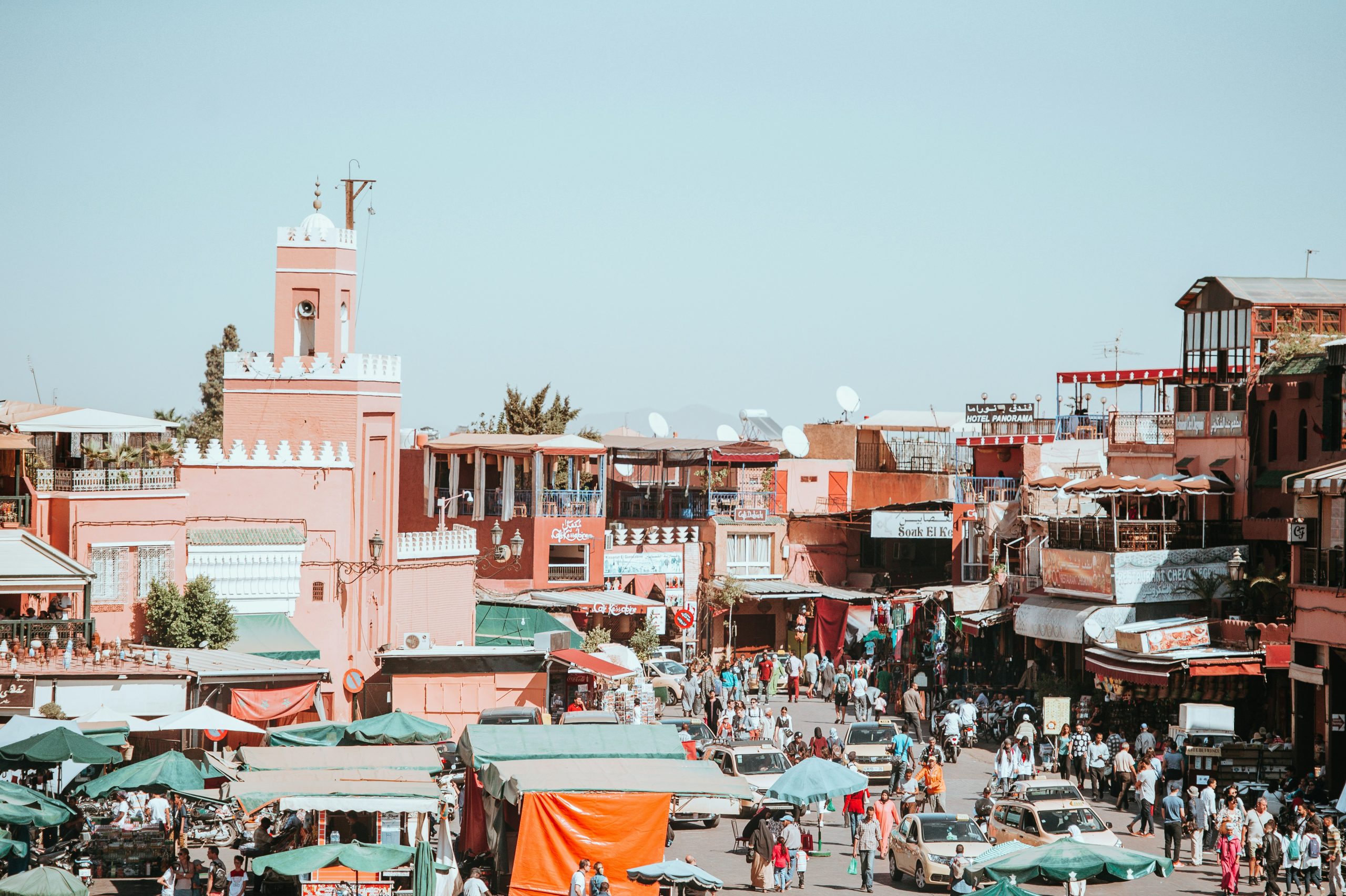Introduction
Marrakech, celebrated as the “Red City” of Morocco, weaves together a captivating blend of historical grandeur and modern refinement. This vibrant metropolis invites exploration through its dynamic streets, where centuries-old traditions coexist with contemporary cultural expressions. As a nexus of culture, commerce, and tradition, Marrakech captivates visitors with its sensory tapestry—an amalgamation of vivid hues, resonant sounds, and an aromatic symphony of spices. Whether you are venturing into its labyrinthine souks for the first time or revisiting its architectural splendor, this comprehensive guide offers an exhaustive framework to optimize your engagement with this multifaceted city.
1. Accessing Marrakech
Air Travel and Ground Transport
Marrakech is anchored on the global travel map by the strategically situated Marrakech Menara Airport (RAK). This facility ensures seamless connectivity with major hubs across Europe, the Middle East, and other regions, serviced by airlines such as Royal Air Maroc, EasyJet, and Ryanair.
Strategic Insight: Securing a private transfer or pre-arranged hotel transportation mitigates the complexities of negotiating local taxi services upon arrival.
Immigration and Visa Protocols
Travelers from jurisdictions including the UK, US, EU, Canada, and Australia benefit from visa-free access to Morocco for a duration not exceeding 90 days. Ensure the validity of your passport extends at least six months beyond your intended departure, as many countries require this buffer to prevent travel disruptions and comply with international entry regulations.
Optimal Seasonal Planning
While Marrakech enjoys abundant sunshine year-round, discerning travelers often prioritize visits during:
- Spring (March-May): Characterized by temperate weather and floral efflorescence.
- Autumn (September-November): Offering a climate conducive to outdoor exploration without the intensity of summer heat.
Summer months, although marked by soaring temperatures, present opportunities for budget-conscious travelers to secure premium accommodations at reduced rates.
2. Accommodations: Curated Luxury and Authenticity
The Allure of Riads
Riads, emblematic of Moroccan architectural ingenuity, are traditional domiciles transformed into boutique lodgings centered around tranquil courtyards. Often, these courtyards feature ornate zellige tilework, lush foliage, and soothing fountains, creating a serene oasis that contrasts with the bustling city outside. Their distinct aesthetic and intimate scale render them an unparalleled choice for cultural immersion.
Exemplary Riads:
- Riad Yasmine: Renowned for its verdant pool and design-oriented ethos.
- Royal Mansour: A regal sanctuary epitomizing opulence, commissioned under royal patronage.
- Dar Darma: A refined haven balancing heritage craftsmanship with contemporary amenities.
Contemporary Hospitality: Hotels and Resorts
For those inclined toward modern luxury, Marrakech boasts an array of internationally acclaimed hotels.
Distinguished Venues:
- La Mamounia: A perennial contender among the world’s premier hotels, celebrated for its expansive gardens.
- Mandarin Oriental: An enclave of private villas enveloped by olive groves.
- Four Seasons Marrakech: A family-centric property with commanding views of the Atlas Mountains.
Neighborhood Dynamics
Marrakech’s distinct districts cater to varied traveler proclivities:
- Medina: An immersive experience in historical and cultural exploration.
- Hivernage: Distinguished by luxury accommodations and a vibrant nightlife.
- Guéliz: A cosmopolitan enclave featuring designer boutiques and avant-garde cafes.
- Palmeraie: A serene oasis ideal for exclusive retreats and outdoor recreation.
3. Experiential Highlights: Landmarks and Activities
The Medina and its Souks
Designated a UNESCO World Heritage site, the Medina serves as the pulsating core of Marrakech. Its intricate alleys host souks offering artisanal goods ranging from handwoven textiles to ornate lanterns.
Essential Experiences:
- Jemaa el-Fnaa: By evening, this iconic square transforms into a vibrant tableau of culinary stalls, performers, and traditional musicians.
- Souk Semmarine: A bustling marketplace specializing in jewelry, pottery, and fabrics.
Architectural and Historical Marvels
The city’s heritage is encapsulated in its meticulously preserved monuments:
- Bahia Palace: A testament to Moroccan craftsmanship, featuring mosaic-clad interiors.
- Koutoubia Mosque: Marrakech’s architectural apex, defined by its iconic minaret.
- Ben Youssef Madrasa: A 14th-century Islamic college showcasing zellige tilework and intricate wood carvings.
- Saadian Tombs: An opulent necropolis rediscovered in the 20th century, emblematic of Saadian-era grandeur.
Verdant Retreats
Amid the urban dynamism, Marrakech’s gardens provide sanctuaries of serenity:
- Jardin Majorelle: An exotic botanical masterpiece with cobalt-blue structures once curated by Yves Saint Laurent.
- Menara Gardens: A historical olive grove punctuated by a reflecting pool.
- Agafay Desert: A nearby rocky expanse offering camel treks, quad biking, and unparalleled stargazing.
4. Culinary Explorations
Traditional Moroccan Gastronomy
Marrakech’s culinary tapestry is rich with emblematic dishes:
- Tagines: Aromatic stews enriched with regional spices, featuring ingredients like lamb and prunes.
- Couscous: A celebratory staple traditionally served on Fridays.
- Pastilla: A savory-sweet pastry layered with spiced meat and dusted with sugar and cinnamon.
Culinary Landmarks:
- Nomad: Offering elevated Moroccan cuisine with panoramic rooftop views.
- Al Fassia: Celebrated for its adherence to traditional recipes and all-female kitchen staff.
Street Food and Local Delicacies
Jemaa el-Fnaa’s food stalls provide an authentic gastronomic foray. One must try the iconic snail soup, served steaming hot and brimming with spices, from a vendor whose bubbling cauldron is a staple of the square. This dish offers a unique taste of local tradition, complemented by the lively ambiance of the market. Highlights include freshly pressed orange juice, grilled kebabs, and msemen (Moroccan flatbread).
Fine Dining
For a refined culinary narrative, consider:
- Dar Yacout: A gastronomic institution housed in an opulent setting.
- La Grande Table Française: Michelin-caliber French-Moroccan fusion cuisine.
Immersive Culinary Workshops
Uncover the intricacies of Moroccan cooking through interactive classes:
- La Maison Arabe: Featuring a dual approach combining market tours with hands-on preparation.
- Amal Women’s Training Center: A socially impactful initiative empowering women through culinary education.
5. Commerce and Craftsmanship
Souk Navigation
Shopping in Marrakech entails skillful bargaining and an appreciation for artisanal heritage. For instance, when negotiating for a handwoven Berber rug, it is customary to offer an initial bid at half the asking price, gradually increasing as the seller counteroffers. This exchange often unfolds over mint tea, emphasizing the social and relational aspects of commerce in Moroccan culture.
Coveted Purchases:
- Berber carpets of intricate design.
- Leather goods, including slippers and handbags.
- Argan oil and a myriad of culinary spices.
- Handcrafted pottery and lanterns.
Contemporary Boutiques
Modern interpretations of Moroccan craftsmanship are showcased in upscale venues within Guéliz and Sidi Ghanem:
- 33 Rue Majorelle: A curated repository of local designer creations.
- Moor: Renowned for minimalist adaptations of traditional patterns.
6. Pragmatic Considerations
Monetary Transactions
The Moroccan Dirham (MAD) is the operational currency. Visitors are advised to exchange funds at authorized facilities or withdraw from ATMs. While credit cards are accepted in upscale settings, cash remains indispensable in traditional markets.
Linguistic Proficiency
While Arabic and French dominate as official languages, English is widely understood in tourist-centric locales.
Health and Safety Protocols
- Prioritize bottled or filtered water over tap water.
- Exercise vigilance to avoid common scams.
- Adhere to conservative dress codes in culturally sensitive spaces.
Urban Mobility
- Petit Taxis: Ideal for intra-city transit, albeit requiring pre-negotiated fares.
- Car Rentals: Suitable for excursions beyond the city but ill-advised within Medina confines.
- Pedestrian Exploration: Optimal for navigating the Medina’s narrow pathways.
7. Regional Excursions
Atlas Mountains and Berber Heritage
A short distance from Marrakech, the Atlas Mountains afford opportunities for trekking and cultural engagement with Berber communities.
Essaouira
This coastal town, replete with fortified walls and vibrant souks, provides a maritime counterpoint to Marrakech’s inland character.
Ouzoud Waterfalls
An ecological gem offering dramatic cascades, ideal for both photography and hiking.
Ourika Valley
Renowned for its verdant landscapes and riverside dining, it serves as a summer refuge from the city’s heat.
8. Cultural Acumen
Understanding Moroccan social mores enhances cross-cultural interactions:
- Extend greetings with “Salam Alaikum” (peace be upon you).
- Employ the right hand for eating and financial exchanges.
- Tipping norms range from 10-15% in restaurants to smaller gestures for service staff.
Conclusion
Marrakech epitomizes a nexus of historical profundity and modern allure. Its kaleidoscopic offerings, from the dynamic Jemaa el-Fnaa to the meditative courtyards of its riads, encapsulate a destination that transcends the ordinary. By delving deeply into its cultural, architectural, and gastronomic treasures, visitors can forge enduring connections with this singular city. Marrakech awaits—a journey of discovery and wonder.


